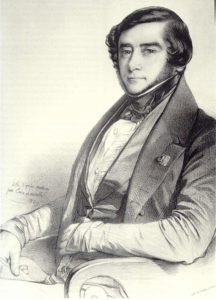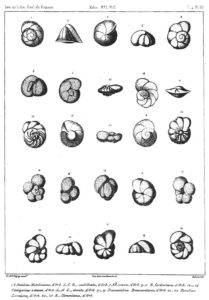The foraminifera are microscopic single-celled marine animals that secrete tiny shells. Under a microscope, they look like miniature mollusks. It took a dedicated and observant French scientist, Alcide d’Orbigny, to figure out what these little creatures were all about.
Alcide d’Orbigny was born in the village of Couëron, France, on the banks of the Loire River not far from the coast, on September 6, 1802 (died 1857). His father, a doctor and naturalist, often took his son to the shore to collect shells, insects, plants and fossils. By age 11, d’Orbigny was hooked—he wanted to become a naturalist. His educational background and early occupation are fuzzy, but he was obviously an astute observer of nature, a talented illustrator and an original thinker.
In 1825, he published a paper on the classification of cephalopods, into which he placed the tiny shelled foraminifera (later, he and others realized the mistaken classification and created a separate phylum for these organisms). He drew exquisite illustrations of many species of foraminifera, and later sculpted plaster models for students to study. That taxonomic work earned him a reputation as a gifted biological scientist.

His reputation landed him an opportunity to explore South America, so he put his work on foraminifera aside for a time. From 1826 to 1834, he participated in an expedition to study the natural history of the continent. He visited Argentina, Brazil, Bolivia, Chile, Peru and Uruguay, collecting, describing and naming more than 1,000 species. He drew beautiful renditions of the specimens he collected. Along the way, he drew the first complete map of South America. Charles Darwin, who didn’t get to South America until 1832, was envious of d’Orbigny, saying that he had probably collected “the cream of all the good things.”
While exploring the Parana River that makes the border between Argentina and Uruguay, d’Orbigny discovered rich beds of fossils in the exposed cliffs along the river. He recognized that these fossils, including pollen grains, mollusks and his beloved foraminifera, were distributed in distinct layers. He reasoned that by aging the fossils, the layers could be dated—an original concept. He continued his work on tiny fossils when he returned to France, and became an expert on the taxonomy of micro-fossils, naming more than 2,800 fossil species. His work on micro-fossils later became a major tool in oil exploration, using the fossils in cores to assess the likelihood that oil lay below.
His fossil work earned him a position as the first professor of paleontology at the Paris Museum of Natural History and recognition as the “father of micropaleontology.” His descriptions of the relationships between fossils and mineral layers in the soil led to the development of the field of biostratigraphy. His major work on the fossils of France, thousands of pages of descriptions and drawings, was never completed; he died an unexpected early death at age 54. Dozens of species and genera are named in his honor.

D’Orbigny achieved a feat that is coveted in today’s scientists, but rarely achieved. He was a “T-shaped” scientist. He was a generalist, working across biological and geological disciplines, developing the breadth associated with the horizontal stroke of the “T.” But he was also a recognized expert on the foraminifera, both extant and fossilized, providing the depth of expertise associated with the vertical stroke of the “T.”
References:
Encyclopedia Britannica. 2018. Alcide Dessalines d’Orbigny. Available at: https://www.britannica.com/biography/Alcide-Dessalines-d-Orbigny. Accessed July 17, 2018.
Letters From Gondwana. 2015. Alcide D’Orbigny and the Beginning of Foraminiferal Studies. Available at: https://paleonerdish.wordpress.com/2015/04/27/alcide-dorbigny-and-the-beginning-of-foraminiferal-studies/. Accessed July 17, 2018.
Lys, Maurice. 1958. Alcide d’Orbigny (1802-1857). Micropaleontology (1958) 4(1):115. Available at: https://pubs.geoscienceworld.org/micropress/micropal/article-abstract/4/1/115/84967/alcide-d-orbigny-1802-1857?redirectedFrom=fulltext. Accessed July 17, 2018.
Scott, Michon. 2018. Alcide d’Orbigny. Strange Science. Available at: https://www.strangescience.net/dorbigny.htm. Accessed July 17, 2018.
